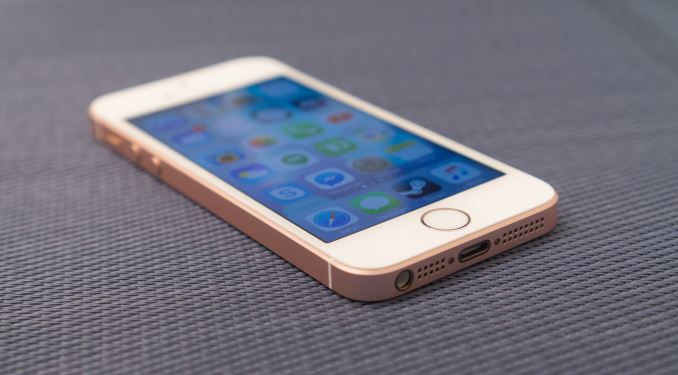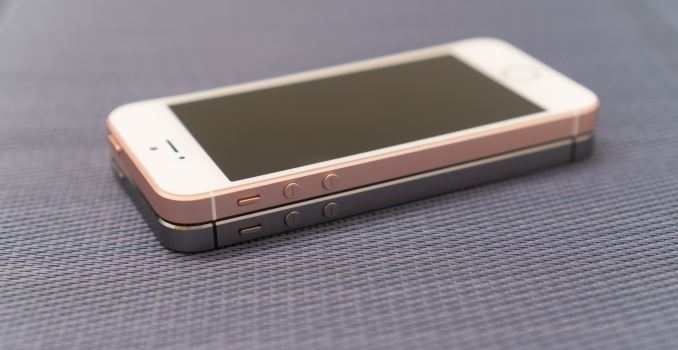The iPhone SE Review
by Brandon Chester on May 16, 2016 8:00 AM EST- Posted in
- Smartphones
- Apple
- Mobile
- iPhone
- iPhone SE
Final Words
It’s really not difficult to come to a conclusion on the iPhone SE. It’s clearly the best 4-inch smartphone on the market, and you can ignore all of the specs when making that assessment because it achieves that by virtue of being the only offering at this size. For the sake of comparison, you can take a look at some Android devices that are larger than the SE, but smaller than your average Android smartphone.
As I said earlier in the review, Android manufacturers have essentially given up on making small smartphones, and most of them haven’t actually made a top tier smartphone at the 4-inch size in about four years. By 2012 things had moved to 4.5 inches or more, with Samsung also introducing the original 5.3-inch Galaxy Note near the end of 2011. Today’s idea of a compact Android phone is something like the Xperia Z5 compact, where the screen has a size of 4.6 inches, which is just a bit smaller than the screen on the iPhone 6s. Getting an even smaller screen means moving to truly low end smartphones like the Moto E, and at that point you’re discussing two entirely different parts of the market.
Even when you consider the smallest high-end devices from the Android manufacturers, it’s not hard to see that the iPhone SE comes out on top. Apple’s A9 SoC is still one of the fastest chips you’ll find in a smartphone, and it goes without saying that the Snapdragon 810 SoC in a smartphone like the Xperia Z5 Compact really isn’t comparable in the slightest. Based on my experience, the camera is also unmatched at this size and price. It’s certainly a step behind the best Android phones and the iPhone 6s Plus, but bringing the sensor from the iPhone 6s to the SE allows for some really great photos, and the best 4K recording video you’ll get on a phone.
The 4-inch IPS display on the iPhone SE has great calibration, and in general the resolution is sufficient to avoid aliasing, although it’s obviously not as sharp as what you’ll get on many Android smartphones. My main complaint about the display is the low contrast ratio and high black level, which is definitely noticeable in real-world use when you compare to more modern LCD displays or any AMOLED panel. Apple definitely intends to keep this phone around for at least a couple of years, if not three, and it’s not going to take remotely that long for the SE’s display to fall quite a few steps behind the market. As far as future-proofing goes, the display is probably the iPhone SE’s one weak spot, although right now it’s still a nice IPS display.
Finally, we have the design of the phone. It’s really unchanged from the iPhone 5s, and some may consider that a bad thing, but I think it’s a good thing. The design still holds up, and there’s absolutely no reason to arbitrarily redesign a product every cycle. The products that are used as examples of good design are often ones that have kept the same design for many years, and in some cases many decades. I can definitely understand those who wanted a device that was more like a small iPhone 6s, but for me the aesthetics of the iPhone 5 era design come out ahead.
Ultimately, the iPhone SE is the upgrade that Apple’s 4-inch iPhone has needed for a while. Considering that it’s been over two years, it’d be hard to not improve, but the fact that you get the same performance, camera, and display calibration as the iPhone 6s is quite appealing when the phone costs $250 less. Battery life is better or worse than the 6s depending on the situation, but it’s definitely improved overall from the 5s. Faster LTE and much faster WiFi are nice improvements too, and you also have Apple Pay thrown in. There’s not much more than Apple could have included without further cutting into their margins and making it really hard to explain why the 6s is significantly more expensive. Even with the things you lose out on, I still find myself asking whether the 6s is truly worth that $250 premium.
While I’ve used the iPhone SE as my daily driver for a month, I expect that I’ll be going back to the Nexus 5X and iPhone 6s. The smaller display is just not for me, but when Apple can sell thirty million two-year-old 4-inch smartphones in a year there’s clearly demand for a smaller smartphone with high end specs. The iPhone SE delivers that, and I think users who have been holding on to an iPhone 5 or 5s should seriously consider it, because it’s the phone that they’ve been waiting for.












138 Comments
View All Comments
Alexey291 - Monday, May 16, 2016 - link
So it's kinda buggy, badly built but you love it? Kaywhiteiphoneproblems - Monday, May 16, 2016 - link
Yep - two minor bugs. Never owned a phone (by any manufacturer) that was bug-free!Impulses - Monday, May 16, 2016 - link
They sound more like hardware faults or QC issues than bugs to me, but maybe we have different definitions of said word...whiteiphoneproblems - Tuesday, May 17, 2016 - link
That other guy called it "buggy"; OK word by me, I guess. The power button issue has been widely reported (think it goes back to the 5S), so don't know if a hardware swap would be worthwhile. (With a case, it's barely noticeable.)Don't know if the brightness thing is software or hardware. Maybe it's calibrated to work that way for this model? I can investigate further, I suppose.
All told, the advantages of this phone far outweigh these imperfections for me.
Klug4Pres - Monday, May 16, 2016 - link
I see a problem with Apple's strategy here.People who cannot afford Apple's larger phones do not necessarily want a smaller phone.
There is also the old problem that people who want large screen phones do not necessarily want gigantic bezels on their phones.
Might there be better ways to differentiate the product line?
Guspaz - Monday, May 16, 2016 - link
I helped my mother buy an iPhone SE yesterday (which was tricky since we visited 6 cellphone stores, all of which were sold out, before we finally found a store that had one in stock). She was upgrading from an iPhone 4S, since it was getting on in years and they'll likely discontinue software support for it this fall.For her, it was the perfect choice: she didn't like the iPhone 6S due to the much larger screen, and the much larger price. The iPhone SE sells for $579 CAD, while the iPhone 6S sells for $915 CAD (or at least it did yesterday in-store, looks like it's gone down to $899 since), which is a big price difference.
She was happy. A lighter phone without much of a size increase, at $336 cheaper than the 6S.
UtilityMax - Tuesday, May 17, 2016 - link
The fact that your ma likes a phone with a small screen does not disprove the previous argument. Apple has a huge problem on its hands. There are plenty of great android smartphones with large screens sold for under $400, heck many are priced exactly at around 200 bucks. Throwing a bone in the form of cheaper and smaller iPhone SE to the consumers looking for value will not appease most of them them.michael2k - Tuesday, May 17, 2016 - link
On the other hand, Apple has no competition in this space, as everything else in this size is significantly slower in CPU, GPU, and NAND.So people who want a small phone can get the SE, and have the fastest and most powerful phone. People who want a large phone can get the 6S and still have the fastest and most powerful phone.
jerrytouille - Monday, May 16, 2016 - link
Which CPU did the SE tested have: Samsung or TSMC?Spectrophobic - Monday, May 16, 2016 - link
Doesn't matter. Margin of error difference.